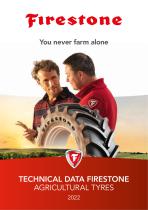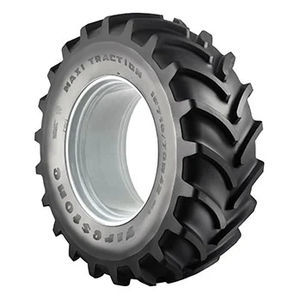
Tractor tire MAXI TRACTION38"30"28"
Add to favorites
Compare this product
fo_shop_gate_exact_title
Characteristics
- Application
- for tractors
- Rim diameter
- 28", 38", 30", 42"
- Other characteristic
- self-cleaning
- Speed index
- E
- Load index
- 154, 166, 155, 160, 173, 168, 151, 158, 163, 157
- Width
710 mm
(28 in)- Height
70 mm
(2.76 in)
Description
TRACTION
High level of traction
Large footprint to transmit traction to the ground.
■ Footprint larger than standard series tyre
Faster working due to better traction through larger footprint.
Dual Angle lug design to increase traction and limit soil disturbance
■ Firestone’s unique and patented Dual Angle Lug design delivers a greater soil contact area than a standard lug. The Dual Angle Lug, combined with its large surface area, provides strong grip and excellent traction.
PRESSURE
Working at pressures between 0.6 bar and 2.4 bar.
Up to 3.0 bar for field cyclic operations below 10 km/h.
■ Robust casing and improved resistance thanks to Firestone’s strong and long-lasting casing and wear-resistant compound.
SOIL CARE
Better soil protection
■ Long footprint allows a better load distribution on soil, and so reduces compaction.
LOAD CAPACITY
High capacity
■ On the road: carrying bigger loads means fewer transport cycles. At same speed and same pressure, you gain up to 30% load capacity versus standard tyres.
REDUCTION OF OPERATING COSTS
Increases productivity through
Maxi Traction tyres contribute to operating costs reduction through:
■ Time savings: due to better traction.
■ Potential fuel savings thanks to better traction.
■ Time savings on road: tyre can carry a heavier loads than a standard series.
■ The advantages? Fewer transport cycles, lower costs.
■ Strong and long-lasting casing and wear-resistant compound, combined with MAXI TRACTION lug design result in outstanding tyre life.
Catalogs
*Prices are pre-tax. They exclude delivery charges and customs duties and do not include additional charges for installation or activation options. Prices are indicative only and may vary by country, with changes to the cost of raw materials and exchange rates.










